Evidence-Based Practice NSG 5210
VerifiedAdded on 2022/09/07
|7
|2555
|23
AI Summary
Contribute Materials
Your contribution can guide someone’s learning journey. Share your
documents today.
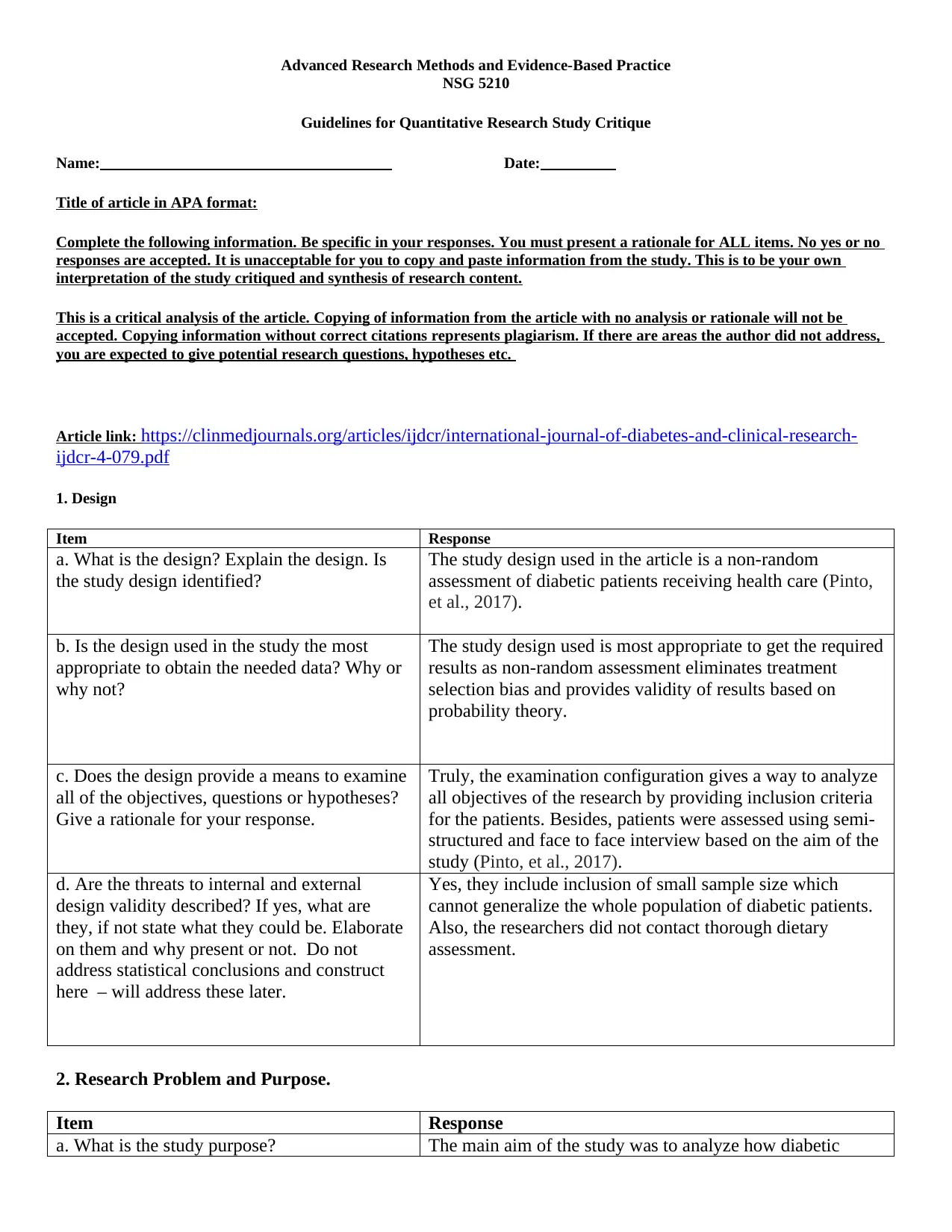
Advanced Research Methods and Evidence-Based Practice
NSG 5210
Guidelines for Quantitative Research Study Critique
Name: Date:
Title of article in APA format:
Complete the following information. Be specific in your responses. You must present a rationale for ALL items. No yes or no
responses are accepted. It is unacceptable for you to copy and paste information from the study. This is to be your own
interpretation of the study critiqued and synthesis of research content.
This is a critical analysis of the article. Copying of information from the article with no analysis or rationale will not be
accepted. Copying information without correct citations represents plagiarism. If there are areas the author did not address,
you are expected to give potential research questions, hypotheses etc.
Article link: https://clinmedjournals.org/articles/ijdcr/international-journal-of-diabetes-and-clinical-research-
ijdcr-4-079.pdf
1. Design
Item Response
a. What is the design? Explain the design. Is
the study design identified?
The study design used in the article is a non-random
assessment of diabetic patients receiving health care (Pinto,
et al., 2017).
b. Is the design used in the study the most
appropriate to obtain the needed data? Why or
why not?
The study design used is most appropriate to get the required
results as non-random assessment eliminates treatment
selection bias and provides validity of results based on
probability theory.
c. Does the design provide a means to examine
all of the objectives, questions or hypotheses?
Give a rationale for your response.
Truly, the examination configuration gives a way to analyze
all objectives of the research by providing inclusion criteria
for the patients. Besides, patients were assessed using semi-
structured and face to face interview based on the aim of the
study (Pinto, et al., 2017).
d. Are the threats to internal and external
design validity described? If yes, what are
they, if not state what they could be. Elaborate
on them and why present or not. Do not
address statistical conclusions and construct
here – will address these later.
Yes, they include inclusion of small sample size which
cannot generalize the whole population of diabetic patients.
Also, the researchers did not contact thorough dietary
assessment.
2. Research Problem and Purpose.
Item Response
a. What is the study purpose? The main aim of the study was to analyze how diabetic
NSG 5210
Guidelines for Quantitative Research Study Critique
Name: Date:
Title of article in APA format:
Complete the following information. Be specific in your responses. You must present a rationale for ALL items. No yes or no
responses are accepted. It is unacceptable for you to copy and paste information from the study. This is to be your own
interpretation of the study critiqued and synthesis of research content.
This is a critical analysis of the article. Copying of information from the article with no analysis or rationale will not be
accepted. Copying information without correct citations represents plagiarism. If there are areas the author did not address,
you are expected to give potential research questions, hypotheses etc.
Article link: https://clinmedjournals.org/articles/ijdcr/international-journal-of-diabetes-and-clinical-research-
ijdcr-4-079.pdf
1. Design
Item Response
a. What is the design? Explain the design. Is
the study design identified?
The study design used in the article is a non-random
assessment of diabetic patients receiving health care (Pinto,
et al., 2017).
b. Is the design used in the study the most
appropriate to obtain the needed data? Why or
why not?
The study design used is most appropriate to get the required
results as non-random assessment eliminates treatment
selection bias and provides validity of results based on
probability theory.
c. Does the design provide a means to examine
all of the objectives, questions or hypotheses?
Give a rationale for your response.
Truly, the examination configuration gives a way to analyze
all objectives of the research by providing inclusion criteria
for the patients. Besides, patients were assessed using semi-
structured and face to face interview based on the aim of the
study (Pinto, et al., 2017).
d. Are the threats to internal and external
design validity described? If yes, what are
they, if not state what they could be. Elaborate
on them and why present or not. Do not
address statistical conclusions and construct
here – will address these later.
Yes, they include inclusion of small sample size which
cannot generalize the whole population of diabetic patients.
Also, the researchers did not contact thorough dietary
assessment.
2. Research Problem and Purpose.
Item Response
a. What is the study purpose? The main aim of the study was to analyze how diabetic
Secure Best Marks with AI Grader
Need help grading? Try our AI Grader for instant feedback on your assignments.
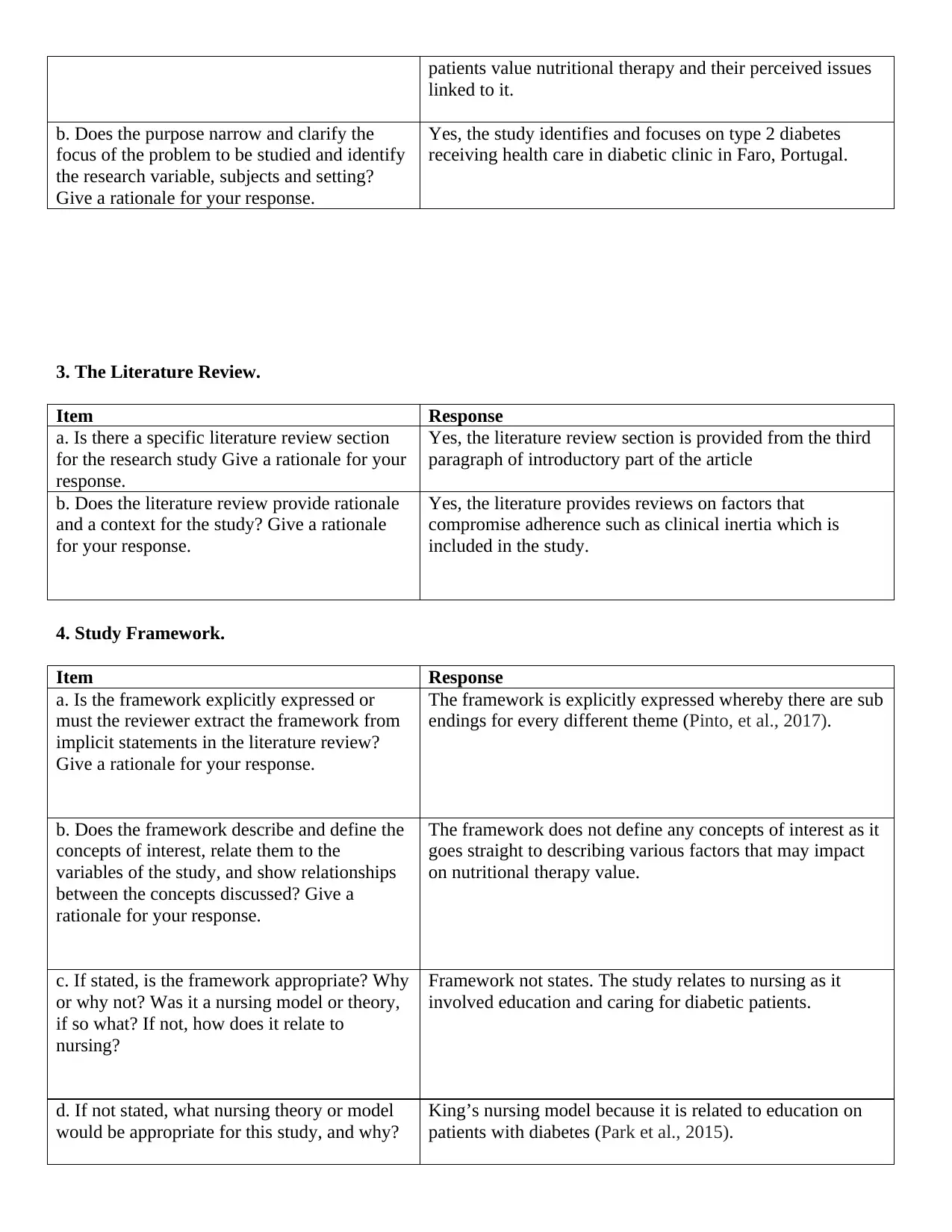
patients value nutritional therapy and their perceived issues
linked to it.
b. Does the purpose narrow and clarify the
focus of the problem to be studied and identify
the research variable, subjects and setting?
Give a rationale for your response.
Yes, the study identifies and focuses on type 2 diabetes
receiving health care in diabetic clinic in Faro, Portugal.
3. The Literature Review.
Item Response
a. Is there a specific literature review section
for the research study Give a rationale for your
response.
Yes, the literature review section is provided from the third
paragraph of introductory part of the article
b. Does the literature review provide rationale
and a context for the study? Give a rationale
for your response.
Yes, the literature provides reviews on factors that
compromise adherence such as clinical inertia which is
included in the study.
4. Study Framework.
Item Response
a. Is the framework explicitly expressed or
must the reviewer extract the framework from
implicit statements in the literature review?
Give a rationale for your response.
The framework is explicitly expressed whereby there are sub
endings for every different theme (Pinto, et al., 2017).
b. Does the framework describe and define the
concepts of interest, relate them to the
variables of the study, and show relationships
between the concepts discussed? Give a
rationale for your response.
The framework does not define any concepts of interest as it
goes straight to describing various factors that may impact
on nutritional therapy value.
c. If stated, is the framework appropriate? Why
or why not? Was it a nursing model or theory,
if so what? If not, how does it relate to
nursing?
Framework not states. The study relates to nursing as it
involved education and caring for diabetic patients.
d. If not stated, what nursing theory or model
would be appropriate for this study, and why?
King’s nursing model because it is related to education on
patients with diabetes (Park et al., 2015).
linked to it.
b. Does the purpose narrow and clarify the
focus of the problem to be studied and identify
the research variable, subjects and setting?
Give a rationale for your response.
Yes, the study identifies and focuses on type 2 diabetes
receiving health care in diabetic clinic in Faro, Portugal.
3. The Literature Review.
Item Response
a. Is there a specific literature review section
for the research study Give a rationale for your
response.
Yes, the literature review section is provided from the third
paragraph of introductory part of the article
b. Does the literature review provide rationale
and a context for the study? Give a rationale
for your response.
Yes, the literature provides reviews on factors that
compromise adherence such as clinical inertia which is
included in the study.
4. Study Framework.
Item Response
a. Is the framework explicitly expressed or
must the reviewer extract the framework from
implicit statements in the literature review?
Give a rationale for your response.
The framework is explicitly expressed whereby there are sub
endings for every different theme (Pinto, et al., 2017).
b. Does the framework describe and define the
concepts of interest, relate them to the
variables of the study, and show relationships
between the concepts discussed? Give a
rationale for your response.
The framework does not define any concepts of interest as it
goes straight to describing various factors that may impact
on nutritional therapy value.
c. If stated, is the framework appropriate? Why
or why not? Was it a nursing model or theory,
if so what? If not, how does it relate to
nursing?
Framework not states. The study relates to nursing as it
involved education and caring for diabetic patients.
d. If not stated, what nursing theory or model
would be appropriate for this study, and why?
King’s nursing model because it is related to education on
patients with diabetes (Park et al., 2015).
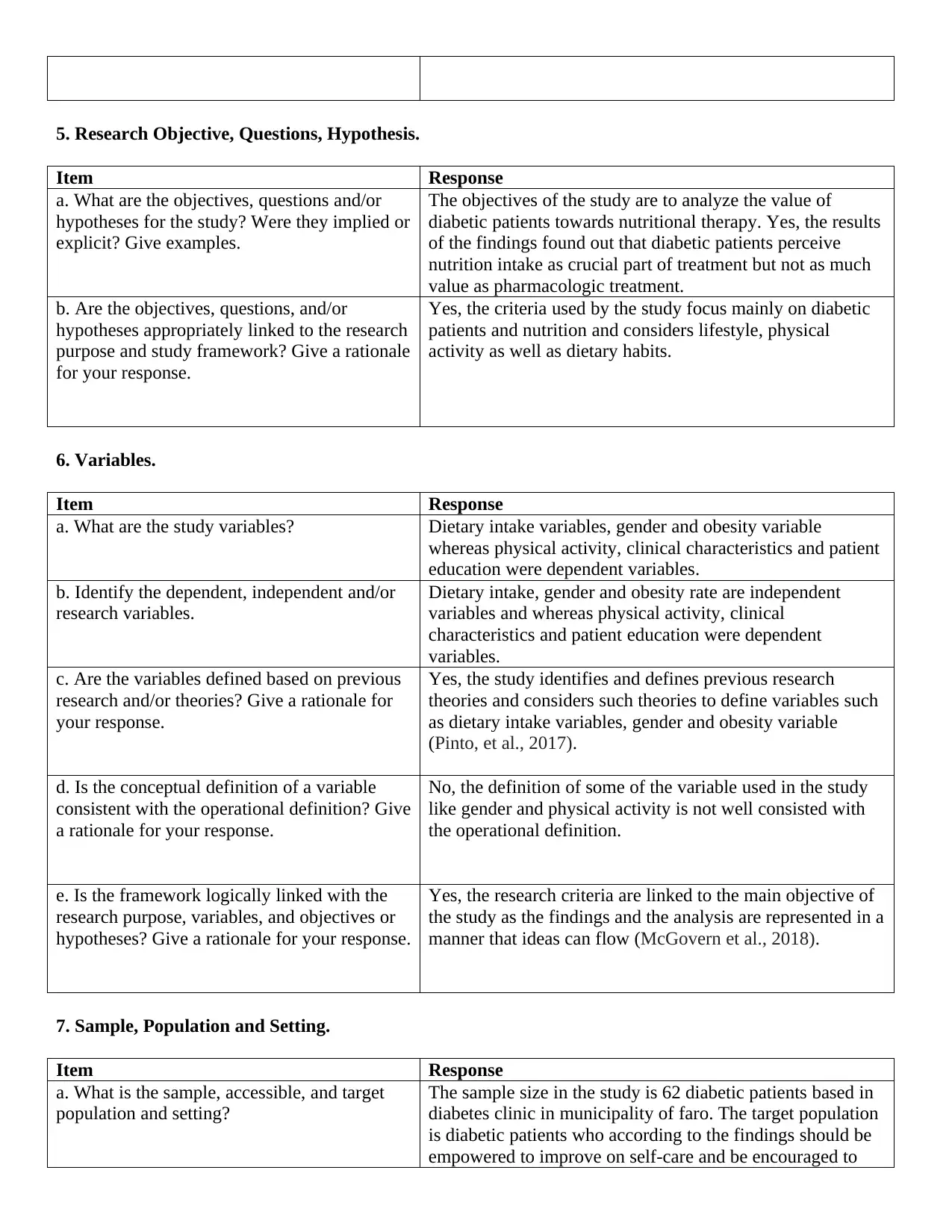
5. Research Objective, Questions, Hypothesis.
Item Response
a. What are the objectives, questions and/or
hypotheses for the study? Were they implied or
explicit? Give examples.
The objectives of the study are to analyze the value of
diabetic patients towards nutritional therapy. Yes, the results
of the findings found out that diabetic patients perceive
nutrition intake as crucial part of treatment but not as much
value as pharmacologic treatment.
b. Are the objectives, questions, and/or
hypotheses appropriately linked to the research
purpose and study framework? Give a rationale
for your response.
Yes, the criteria used by the study focus mainly on diabetic
patients and nutrition and considers lifestyle, physical
activity as well as dietary habits.
6. Variables.
Item Response
a. What are the study variables? Dietary intake variables, gender and obesity variable
whereas physical activity, clinical characteristics and patient
education were dependent variables.
b. Identify the dependent, independent and/or
research variables.
Dietary intake, gender and obesity rate are independent
variables and whereas physical activity, clinical
characteristics and patient education were dependent
variables.
c. Are the variables defined based on previous
research and/or theories? Give a rationale for
your response.
Yes, the study identifies and defines previous research
theories and considers such theories to define variables such
as dietary intake variables, gender and obesity variable
(Pinto, et al., 2017).
d. Is the conceptual definition of a variable
consistent with the operational definition? Give
a rationale for your response.
No, the definition of some of the variable used in the study
like gender and physical activity is not well consisted with
the operational definition.
e. Is the framework logically linked with the
research purpose, variables, and objectives or
hypotheses? Give a rationale for your response.
Yes, the research criteria are linked to the main objective of
the study as the findings and the analysis are represented in a
manner that ideas can flow (McGovern et al., 2018).
7. Sample, Population and Setting.
Item Response
a. What is the sample, accessible, and target
population and setting?
The sample size in the study is 62 diabetic patients based in
diabetes clinic in municipality of faro. The target population
is diabetic patients who according to the findings should be
empowered to improve on self-care and be encouraged to
Item Response
a. What are the objectives, questions and/or
hypotheses for the study? Were they implied or
explicit? Give examples.
The objectives of the study are to analyze the value of
diabetic patients towards nutritional therapy. Yes, the results
of the findings found out that diabetic patients perceive
nutrition intake as crucial part of treatment but not as much
value as pharmacologic treatment.
b. Are the objectives, questions, and/or
hypotheses appropriately linked to the research
purpose and study framework? Give a rationale
for your response.
Yes, the criteria used by the study focus mainly on diabetic
patients and nutrition and considers lifestyle, physical
activity as well as dietary habits.
6. Variables.
Item Response
a. What are the study variables? Dietary intake variables, gender and obesity variable
whereas physical activity, clinical characteristics and patient
education were dependent variables.
b. Identify the dependent, independent and/or
research variables.
Dietary intake, gender and obesity rate are independent
variables and whereas physical activity, clinical
characteristics and patient education were dependent
variables.
c. Are the variables defined based on previous
research and/or theories? Give a rationale for
your response.
Yes, the study identifies and defines previous research
theories and considers such theories to define variables such
as dietary intake variables, gender and obesity variable
(Pinto, et al., 2017).
d. Is the conceptual definition of a variable
consistent with the operational definition? Give
a rationale for your response.
No, the definition of some of the variable used in the study
like gender and physical activity is not well consisted with
the operational definition.
e. Is the framework logically linked with the
research purpose, variables, and objectives or
hypotheses? Give a rationale for your response.
Yes, the research criteria are linked to the main objective of
the study as the findings and the analysis are represented in a
manner that ideas can flow (McGovern et al., 2018).
7. Sample, Population and Setting.
Item Response
a. What is the sample, accessible, and target
population and setting?
The sample size in the study is 62 diabetic patients based in
diabetes clinic in municipality of faro. The target population
is diabetic patients who according to the findings should be
empowered to improve on self-care and be encouraged to
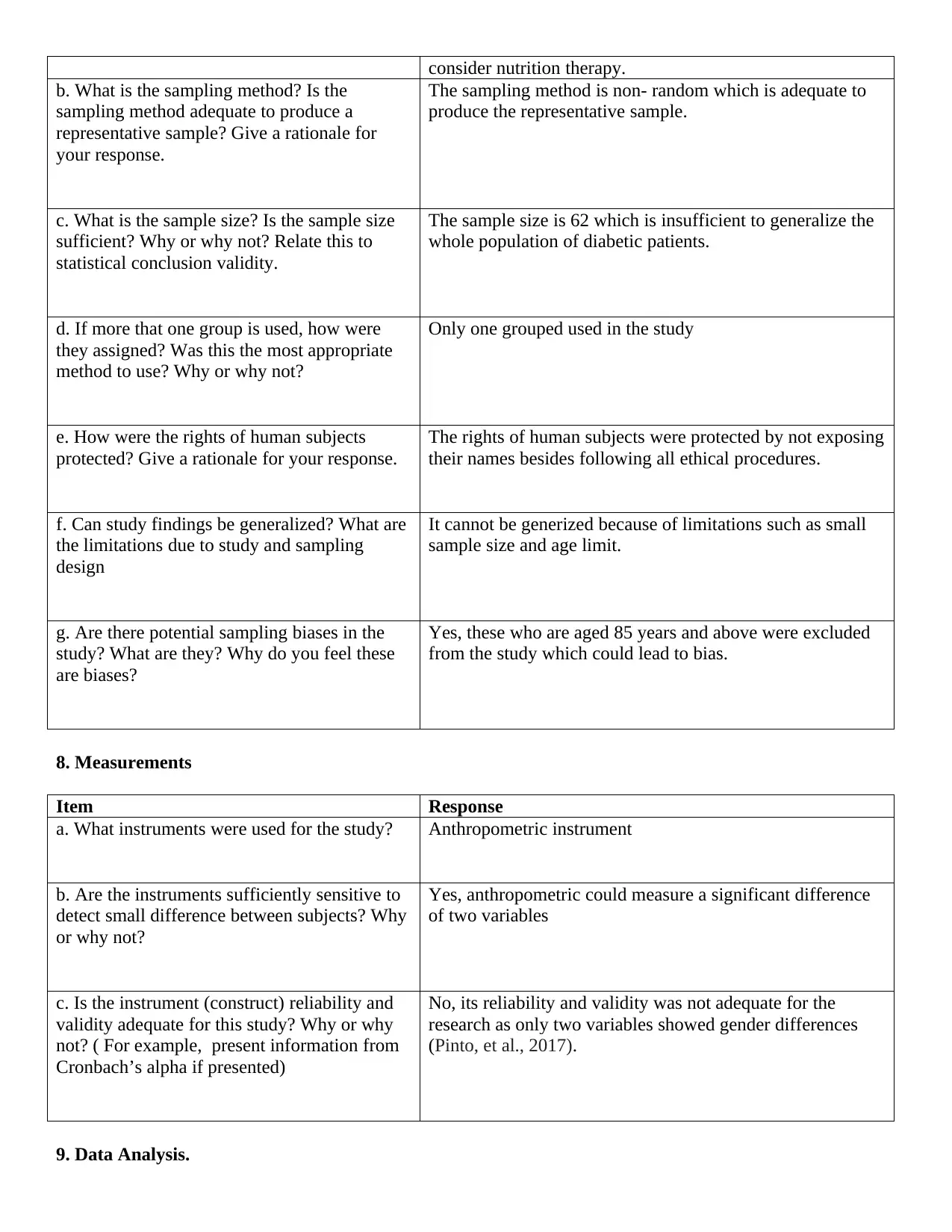
consider nutrition therapy.
b. What is the sampling method? Is the
sampling method adequate to produce a
representative sample? Give a rationale for
your response.
The sampling method is non- random which is adequate to
produce the representative sample.
c. What is the sample size? Is the sample size
sufficient? Why or why not? Relate this to
statistical conclusion validity.
The sample size is 62 which is insufficient to generalize the
whole population of diabetic patients.
d. If more that one group is used, how were
they assigned? Was this the most appropriate
method to use? Why or why not?
Only one grouped used in the study
e. How were the rights of human subjects
protected? Give a rationale for your response.
The rights of human subjects were protected by not exposing
their names besides following all ethical procedures.
f. Can study findings be generalized? What are
the limitations due to study and sampling
design
It cannot be generized because of limitations such as small
sample size and age limit.
g. Are there potential sampling biases in the
study? What are they? Why do you feel these
are biases?
Yes, these who are aged 85 years and above were excluded
from the study which could lead to bias.
8. Measurements
Item Response
a. What instruments were used for the study? Anthropometric instrument
b. Are the instruments sufficiently sensitive to
detect small difference between subjects? Why
or why not?
Yes, anthropometric could measure a significant difference
of two variables
c. Is the instrument (construct) reliability and
validity adequate for this study? Why or why
not? ( For example, present information from
Cronbach’s alpha if presented)
No, its reliability and validity was not adequate for the
research as only two variables showed gender differences
(Pinto, et al., 2017).
9. Data Analysis.
b. What is the sampling method? Is the
sampling method adequate to produce a
representative sample? Give a rationale for
your response.
The sampling method is non- random which is adequate to
produce the representative sample.
c. What is the sample size? Is the sample size
sufficient? Why or why not? Relate this to
statistical conclusion validity.
The sample size is 62 which is insufficient to generalize the
whole population of diabetic patients.
d. If more that one group is used, how were
they assigned? Was this the most appropriate
method to use? Why or why not?
Only one grouped used in the study
e. How were the rights of human subjects
protected? Give a rationale for your response.
The rights of human subjects were protected by not exposing
their names besides following all ethical procedures.
f. Can study findings be generalized? What are
the limitations due to study and sampling
design
It cannot be generized because of limitations such as small
sample size and age limit.
g. Are there potential sampling biases in the
study? What are they? Why do you feel these
are biases?
Yes, these who are aged 85 years and above were excluded
from the study which could lead to bias.
8. Measurements
Item Response
a. What instruments were used for the study? Anthropometric instrument
b. Are the instruments sufficiently sensitive to
detect small difference between subjects? Why
or why not?
Yes, anthropometric could measure a significant difference
of two variables
c. Is the instrument (construct) reliability and
validity adequate for this study? Why or why
not? ( For example, present information from
Cronbach’s alpha if presented)
No, its reliability and validity was not adequate for the
research as only two variables showed gender differences
(Pinto, et al., 2017).
9. Data Analysis.
Secure Best Marks with AI Grader
Need help grading? Try our AI Grader for instant feedback on your assignments.
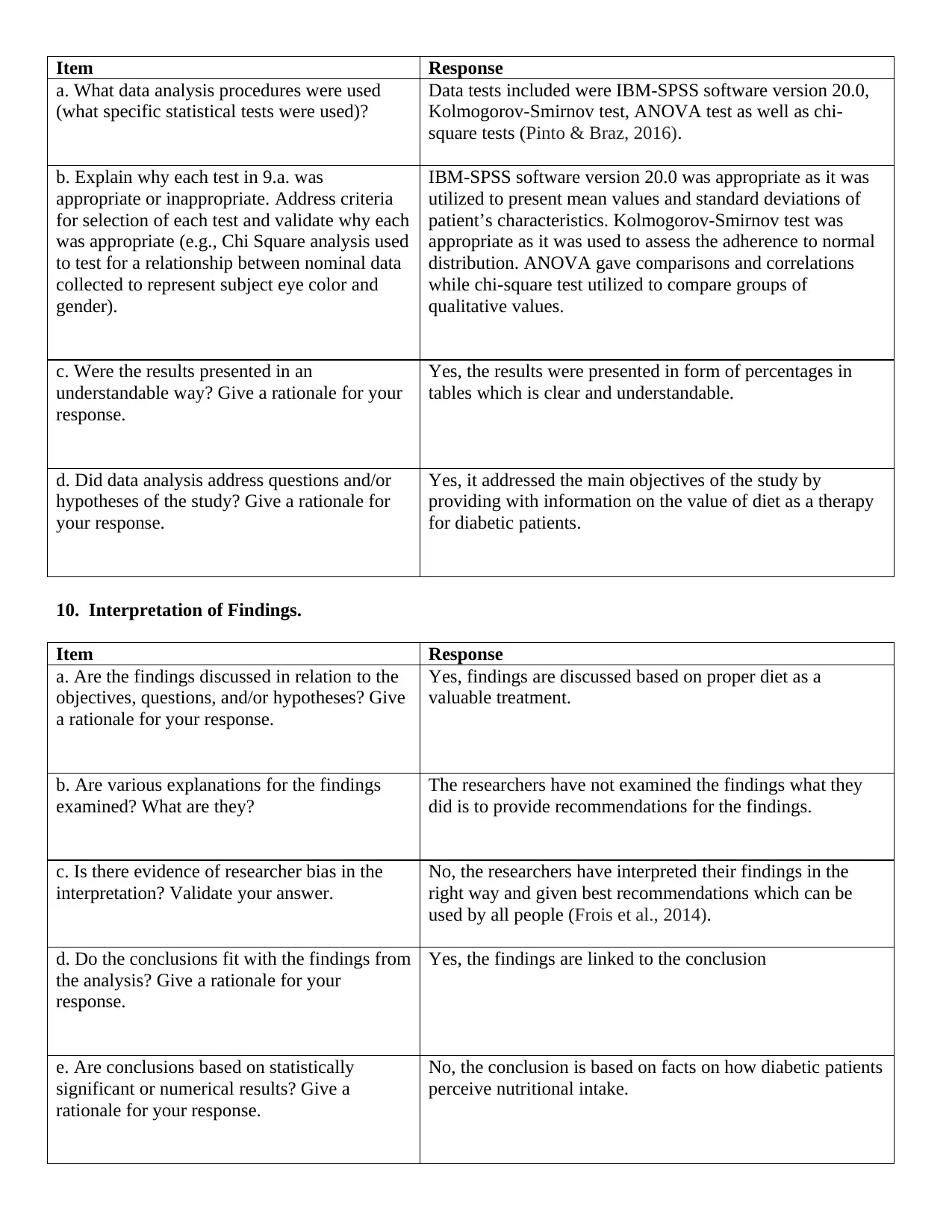
Item Response
a. What data analysis procedures were used
(what specific statistical tests were used)?
Data tests included were IBM-SPSS software version 20.0,
Kolmogorov-Smirnov test, ANOVA test as well as chi-
square tests (Pinto & Braz, 2016).
b. Explain why each test in 9.a. was
appropriate or inappropriate. Address criteria
for selection of each test and validate why each
was appropriate (e.g., Chi Square analysis used
to test for a relationship between nominal data
collected to represent subject eye color and
gender).
IBM-SPSS software version 20.0 was appropriate as it was
utilized to present mean values and standard deviations of
patient’s characteristics. Kolmogorov-Smirnov test was
appropriate as it was used to assess the adherence to normal
distribution. ANOVA gave comparisons and correlations
while chi-square test utilized to compare groups of
qualitative values.
c. Were the results presented in an
understandable way? Give a rationale for your
response.
Yes, the results were presented in form of percentages in
tables which is clear and understandable.
d. Did data analysis address questions and/or
hypotheses of the study? Give a rationale for
your response.
Yes, it addressed the main objectives of the study by
providing with information on the value of diet as a therapy
for diabetic patients.
10. Interpretation of Findings.
Item Response
a. Are the findings discussed in relation to the
objectives, questions, and/or hypotheses? Give
a rationale for your response.
Yes, findings are discussed based on proper diet as a
valuable treatment.
b. Are various explanations for the findings
examined? What are they?
The researchers have not examined the findings what they
did is to provide recommendations for the findings.
c. Is there evidence of researcher bias in the
interpretation? Validate your answer.
No, the researchers have interpreted their findings in the
right way and given best recommendations which can be
used by all people (Frois et al., 2014).
d. Do the conclusions fit with the findings from
the analysis? Give a rationale for your
response.
Yes, the findings are linked to the conclusion
e. Are conclusions based on statistically
significant or numerical results? Give a
rationale for your response.
No, the conclusion is based on facts on how diabetic patients
perceive nutritional intake.
a. What data analysis procedures were used
(what specific statistical tests were used)?
Data tests included were IBM-SPSS software version 20.0,
Kolmogorov-Smirnov test, ANOVA test as well as chi-
square tests (Pinto & Braz, 2016).
b. Explain why each test in 9.a. was
appropriate or inappropriate. Address criteria
for selection of each test and validate why each
was appropriate (e.g., Chi Square analysis used
to test for a relationship between nominal data
collected to represent subject eye color and
gender).
IBM-SPSS software version 20.0 was appropriate as it was
utilized to present mean values and standard deviations of
patient’s characteristics. Kolmogorov-Smirnov test was
appropriate as it was used to assess the adherence to normal
distribution. ANOVA gave comparisons and correlations
while chi-square test utilized to compare groups of
qualitative values.
c. Were the results presented in an
understandable way? Give a rationale for your
response.
Yes, the results were presented in form of percentages in
tables which is clear and understandable.
d. Did data analysis address questions and/or
hypotheses of the study? Give a rationale for
your response.
Yes, it addressed the main objectives of the study by
providing with information on the value of diet as a therapy
for diabetic patients.
10. Interpretation of Findings.
Item Response
a. Are the findings discussed in relation to the
objectives, questions, and/or hypotheses? Give
a rationale for your response.
Yes, findings are discussed based on proper diet as a
valuable treatment.
b. Are various explanations for the findings
examined? What are they?
The researchers have not examined the findings what they
did is to provide recommendations for the findings.
c. Is there evidence of researcher bias in the
interpretation? Validate your answer.
No, the researchers have interpreted their findings in the
right way and given best recommendations which can be
used by all people (Frois et al., 2014).
d. Do the conclusions fit with the findings from
the analysis? Give a rationale for your
response.
Yes, the findings are linked to the conclusion
e. Are conclusions based on statistically
significant or numerical results? Give a
rationale for your response.
No, the conclusion is based on facts on how diabetic patients
perceive nutritional intake.
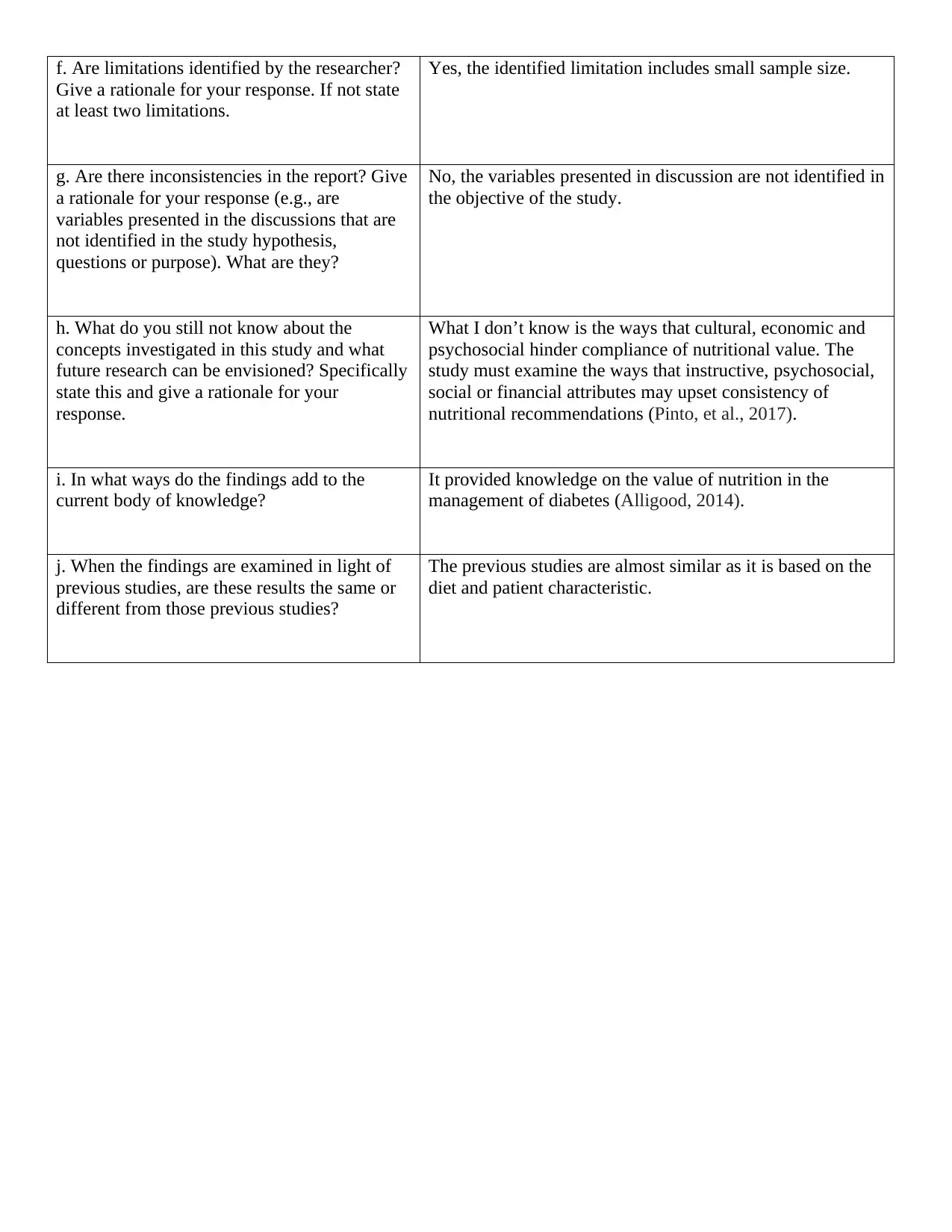
f. Are limitations identified by the researcher?
Give a rationale for your response. If not state
at least two limitations.
Yes, the identified limitation includes small sample size.
g. Are there inconsistencies in the report? Give
a rationale for your response (e.g., are
variables presented in the discussions that are
not identified in the study hypothesis,
questions or purpose). What are they?
No, the variables presented in discussion are not identified in
the objective of the study.
h. What do you still not know about the
concepts investigated in this study and what
future research can be envisioned? Specifically
state this and give a rationale for your
response.
What I don’t know is the ways that cultural, economic and
psychosocial hinder compliance of nutritional value. The
study must examine the ways that instructive, psychosocial,
social or financial attributes may upset consistency of
nutritional recommendations (Pinto, et al., 2017).
i. In what ways do the findings add to the
current body of knowledge?
It provided knowledge on the value of nutrition in the
management of diabetes (Alligood, 2014).
j. When the findings are examined in light of
previous studies, are these results the same or
different from those previous studies?
The previous studies are almost similar as it is based on the
diet and patient characteristic.
Give a rationale for your response. If not state
at least two limitations.
Yes, the identified limitation includes small sample size.
g. Are there inconsistencies in the report? Give
a rationale for your response (e.g., are
variables presented in the discussions that are
not identified in the study hypothesis,
questions or purpose). What are they?
No, the variables presented in discussion are not identified in
the objective of the study.
h. What do you still not know about the
concepts investigated in this study and what
future research can be envisioned? Specifically
state this and give a rationale for your
response.
What I don’t know is the ways that cultural, economic and
psychosocial hinder compliance of nutritional value. The
study must examine the ways that instructive, psychosocial,
social or financial attributes may upset consistency of
nutritional recommendations (Pinto, et al., 2017).
i. In what ways do the findings add to the
current body of knowledge?
It provided knowledge on the value of nutrition in the
management of diabetes (Alligood, 2014).
j. When the findings are examined in light of
previous studies, are these results the same or
different from those previous studies?
The previous studies are almost similar as it is based on the
diet and patient characteristic.
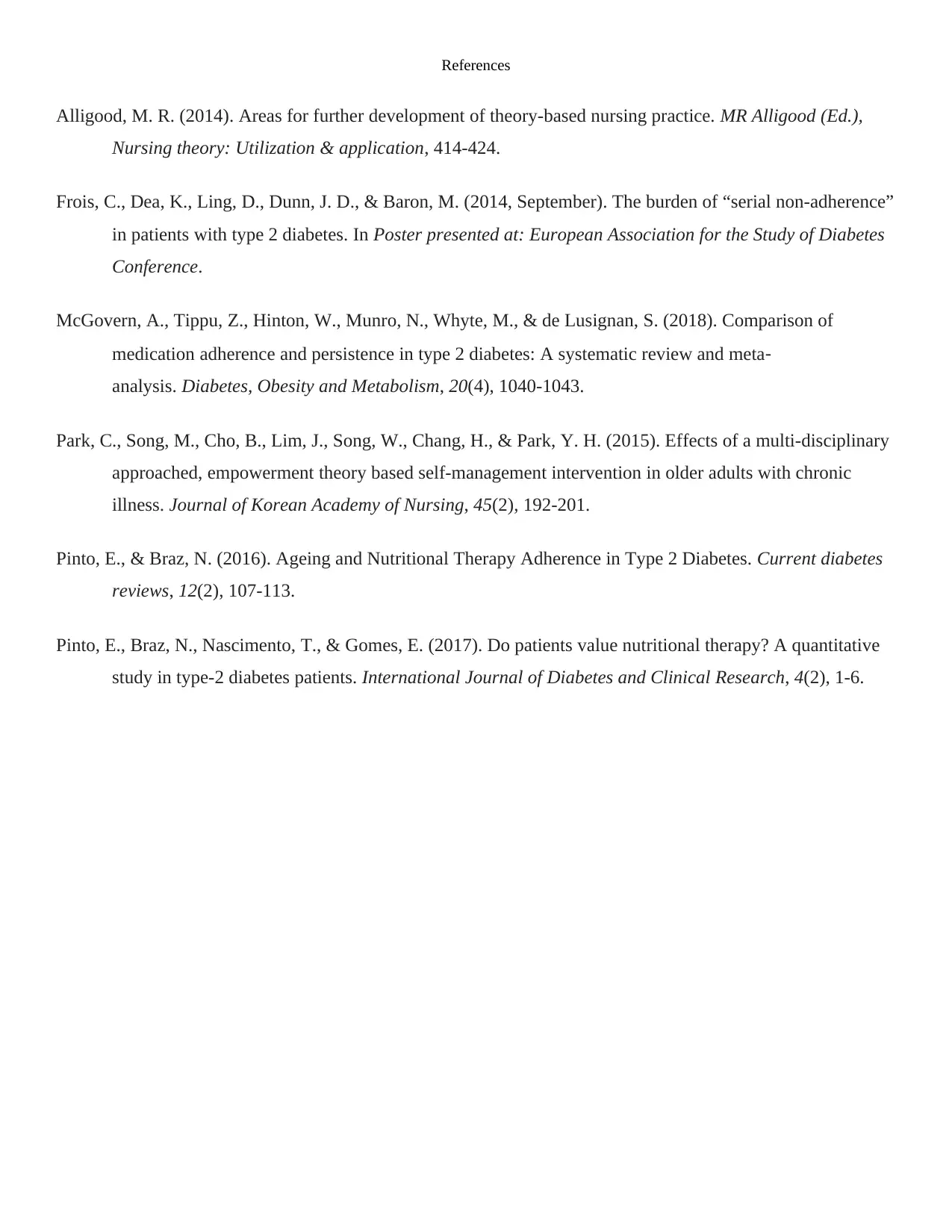
References
Alligood, M. R. (2014). Areas for further development of theory-based nursing practice. MR Alligood (Ed.),
Nursing theory: Utilization & application, 414-424.
Frois, C., Dea, K., Ling, D., Dunn, J. D., & Baron, M. (2014, September). The burden of “serial non-adherence”
in patients with type 2 diabetes. In Poster presented at: European Association for the Study of Diabetes
Conference.
McGovern, A., Tippu, Z., Hinton, W., Munro, N., Whyte, M., & de Lusignan, S. (2018). Comparison of
medication adherence and persistence in type 2 diabetes: A systematic review and meta‐
analysis. Diabetes, Obesity and Metabolism, 20(4), 1040-1043.
Park, C., Song, M., Cho, B., Lim, J., Song, W., Chang, H., & Park, Y. H. (2015). Effects of a multi-disciplinary
approached, empowerment theory based self-management intervention in older adults with chronic
illness. Journal of Korean Academy of Nursing, 45(2), 192-201.
Pinto, E., & Braz, N. (2016). Ageing and Nutritional Therapy Adherence in Type 2 Diabetes. Current diabetes
reviews, 12(2), 107-113.
Pinto, E., Braz, N., Nascimento, T., & Gomes, E. (2017). Do patients value nutritional therapy? A quantitative
study in type-2 diabetes patients. International Journal of Diabetes and Clinical Research, 4(2), 1-6.
Alligood, M. R. (2014). Areas for further development of theory-based nursing practice. MR Alligood (Ed.),
Nursing theory: Utilization & application, 414-424.
Frois, C., Dea, K., Ling, D., Dunn, J. D., & Baron, M. (2014, September). The burden of “serial non-adherence”
in patients with type 2 diabetes. In Poster presented at: European Association for the Study of Diabetes
Conference.
McGovern, A., Tippu, Z., Hinton, W., Munro, N., Whyte, M., & de Lusignan, S. (2018). Comparison of
medication adherence and persistence in type 2 diabetes: A systematic review and meta‐
analysis. Diabetes, Obesity and Metabolism, 20(4), 1040-1043.
Park, C., Song, M., Cho, B., Lim, J., Song, W., Chang, H., & Park, Y. H. (2015). Effects of a multi-disciplinary
approached, empowerment theory based self-management intervention in older adults with chronic
illness. Journal of Korean Academy of Nursing, 45(2), 192-201.
Pinto, E., & Braz, N. (2016). Ageing and Nutritional Therapy Adherence in Type 2 Diabetes. Current diabetes
reviews, 12(2), 107-113.
Pinto, E., Braz, N., Nascimento, T., & Gomes, E. (2017). Do patients value nutritional therapy? A quantitative
study in type-2 diabetes patients. International Journal of Diabetes and Clinical Research, 4(2), 1-6.
1 out of 7
Related Documents
Your All-in-One AI-Powered Toolkit for Academic Success.
+13062052269
info@desklib.com
Available 24*7 on WhatsApp / Email
![[object Object]](/_next/static/media/star-bottom.7253800d.svg)
Unlock your academic potential
© 2024 | Zucol Services PVT LTD | All rights reserved.





